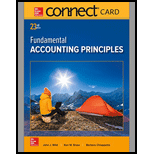
Concept explainers
Concept Introduction
Accounting Process: The Accounting process is a series of activities or processes that start with a financial transaction and end with the closing of books. It is also called accounting cycle because it is repeated in each year.
Analyzing and recording transaction: Analyzing and recording transaction is a step of the accounting process under which identified financial transactions are analyzed to determine the related account and the amount to be recorded and after that record that transaction into the journal through accounting entries.
To Determine: The order of steps given in the question.
Want to see the full answer?
Check out a sample textbook solution
Chapter 2 Solutions
Connect Access Card for Fundamental Accounting Principles
- I need assistance with this financial accounting problem using valid financial procedures.arrow_forwardBowen Corporation had sales revenue of $925,000 and cost of goods sold of $555,000. Operating expenses were $245,000, which included depreciation expense of $35,000. The company also recorded interest expense of $28,000. What was Bowen Corporation's income before taxes?arrow_forwardGenshin Company uses process costing. During March, the packaging department had 8,500 units in beginning work-in-process inventory that were 70% complete. During the month, 42,000 units were started and 37,500 units were completed. Ending work-in-process inventory was 40% complete. Using the weighted-average method, what are the equivalent units for the month? Need helparrow_forward
- Can you solve this general accounting question with accurate accounting calculations?arrow_forwardIn 2019, Philip Industries sold 3,800 units at $275 each. Variable costs were $195 per unit, and fixed costs were $120,000. What was Philip Industries' 2019 net income?arrow_forwardPlease explain the correct approach for solving this financial accounting question.arrow_forward
- A machine costs $50,000 with a salvage value of $5,000 and a useful life of 5 years. Calculate the annual depreciation expense using straight-line, double-declining balance, and sum-of-years-digits methods.arrow_forwardNirvana Technologies has $85,000 in assets. They also have $32,000 in liabilities and $8,500 in expenses, and they paid out $10,000 in dividends this year. The extended accounting equation is assets = liabilities + (revenue - (expenses + dividends)). What would their revenue need to be for their accounts to be in balance?arrow_forwardI need help solving this general accounting question with the proper methodology.arrow_forward

 AccountingAccountingISBN:9781337272094Author:WARREN, Carl S., Reeve, James M., Duchac, Jonathan E.Publisher:Cengage Learning,
AccountingAccountingISBN:9781337272094Author:WARREN, Carl S., Reeve, James M., Duchac, Jonathan E.Publisher:Cengage Learning, Accounting Information SystemsAccountingISBN:9781337619202Author:Hall, James A.Publisher:Cengage Learning,
Accounting Information SystemsAccountingISBN:9781337619202Author:Hall, James A.Publisher:Cengage Learning, Horngren's Cost Accounting: A Managerial Emphasis...AccountingISBN:9780134475585Author:Srikant M. Datar, Madhav V. RajanPublisher:PEARSON
Horngren's Cost Accounting: A Managerial Emphasis...AccountingISBN:9780134475585Author:Srikant M. Datar, Madhav V. RajanPublisher:PEARSON Intermediate AccountingAccountingISBN:9781259722660Author:J. David Spiceland, Mark W. Nelson, Wayne M ThomasPublisher:McGraw-Hill Education
Intermediate AccountingAccountingISBN:9781259722660Author:J. David Spiceland, Mark W. Nelson, Wayne M ThomasPublisher:McGraw-Hill Education Financial and Managerial AccountingAccountingISBN:9781259726705Author:John J Wild, Ken W. Shaw, Barbara Chiappetta Fundamental Accounting PrinciplesPublisher:McGraw-Hill Education
Financial and Managerial AccountingAccountingISBN:9781259726705Author:John J Wild, Ken W. Shaw, Barbara Chiappetta Fundamental Accounting PrinciplesPublisher:McGraw-Hill Education





